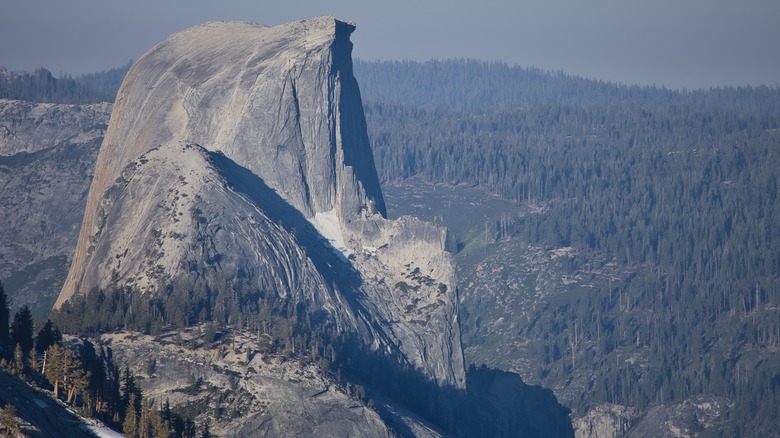The Disturbing Issues With Half Dome Hike's Lottery System
Half Dome in Yosemite is one of the most popular, sought-after hikes in the national park for a good reason. The climb is challenging and unique, as the final 400-foot section of the trail requires you to pull yourself up the side of the giant granite rock using two cables. This feat is rewarding as you are treated to sweeping views of the Yosemite Valley and Sierra Nevada mountains. However, the steep ascent and slippery granite of Half Dome also make this one of the most dangerous hikes in Yosemite. In fact, there have been at least 25 deaths at the Half Dome summit.
In 2010, the National Park Service implemented a permit lottery system in an attempt to keep the trail less congested and increase the hike's safety. This means that every hiker who wants to attempt Half Dome needs to apply for a permit to be allowed on the trail, and the permits are given out based on the luck of the draw. There used to be around 1,000 climbers attempting to make the ascent, but now, only 225 permits are given out each day, meaning that the trail is now much less frequented than it was before the permit system. However, a study published in the Wilderness and Environmental Medicine journal concluded that the number of injuries and deaths on Half Dome did not decrease after the permit system was implemented. This information has caused many to wonder if the lottery system has actually made the hike safer.
Why Half Dome's lottery system doesn't work
Although the lottery was implemented to reduce crowds, thereby reducing accidents, park officials didn't quite take into account that most of the deaths on Half Dome have occurred when the granite was wet. This is true for one tragedy in July 2024, when 20-year-old Grace Rohloff slipped and fell to her death while hiking down the summit with her father in rainy conditions. A park ranger had warned the pair that storms were expected, but Rohloff's father told SFGate that when they reached the bottom of the cables, "the sky was perfectly clear." They decided to continue and try to complete the bucket-list hike, only to get caught in storms on the way back down.
Rohloff's death sparked a debate online about how the lottery system may actually be making Half Dome more dangerous. Since the hiking permits are so difficult to get (with around 19% success rate for the daily lottery, according to the NPS), people may be less willing to turn around due to weather concerns because they don't know when or if they will ever have the chance to try the hike again.
How to hike Yosemite's Half Dome safely
While Half Dome is not one of the U.S. National Park trails only for experienced hikers, it is quite a dangerous undertaking. Plenty of people still attempt to climb the cables to stand atop the 8,836-foot granite dome. We aren't saying that you should completely scratch Half Dome from your bucket list; however, when you do attempt the trek, it is important to know how to do it safely. When hiking, pay attention to local weather reports — if there is rain in the forecast, either don't attempt the climb or plan to be down from the mountain before it hits. Even if the weather seems clear, Yosemite frequently has afternoon storms, so it's a good idea to start your hike early to be able to head down around 1 p.m.
It is also important to refrain from climbing the cables up Half Dome if the ground is wet or if there are any dark clouds in the area. Mountain weather can change quickly, and the last thing you want to happen is to get caught in a storm at the top. You should also consider bringing safety gear with you, like grippy gloves, good hiking shoes, and even a mountaineering harness with a carabiner so that you can clip yourself to the cables. As one Redditor puts it, "I'm more convinced than ever that even a short rope and cheap carabiner are worth it to have that extra safety factor." If you want to brave the hike alone, check out these safety tips to know before your first solo hike.


